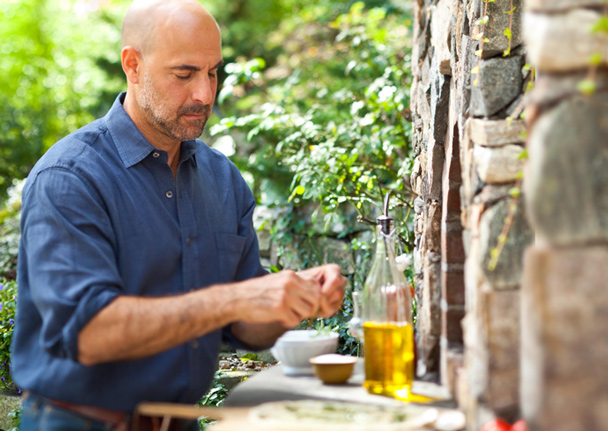You'd think that Stanley Tucci would have enough heaped on his pasta plate, what with a new marriage, three beautiful kids, a role in The Hunger Games, three films in production, and a bevy of awards and nominations, from Emmys to Oscars to Grammys. But somehow the actor and director has found time to publish The Tucci Cookbook, in which he preserves and celebrates the treasures of his southern Italian roots, alongside that of his friend, chef Gianni Scappin, who offers up his own beloved northern Italian dishes. Read on to learn why Tucci wrote the book, his favorite cinematic food scenes, and his fondest food memories.
Gourmet Live: You wrote in your new book, The Tucci Cookbook, that when you grew up in New York's Westchester County, you often wondered, "What does the rest of the world eat? For consistent ingenuity and excellence, my mother's cooking is hard to beat." What are some of your earliest food memories?
Stanley Tucci: Some of the earliest memories I have take place in my maternal grandfather's garden. Walking through the rows of abundant tomato plants, with their distinctive soft smell, pulling heads of garlic from the perfectly cultivated earth, eating the fragrant carrots, the plums, peaches, green apples, figs and the wild mulberries that grew at the rear of the garden. From this garden came so much with which to make wonderful meals. I suppose these are my first "food" memories.
As far as meals go, I remember eating crabs (culled from the Hudson River), spread out on newspaper with ears of steaming corn, my mother's paella, her risotto Milanese, breaded veal cutlets, and eggplant, zucchini, potatoes, and tomato casserole; the latter two I often took to school the next day sandwiched between half a loaf of Italian bread.
On Sunday mornings I clearly remember the aroma of a rich ragù cooking slowly to be eaten later that day with pasta (rigatoni or ziti), and delicate meatballs, which were always served separately, never on the same plate, and "falling off the bone" beef or pork ribs that had been stewing in that same ragù for hours.
GL: Your book is "A collection of recipes from people you love," composed of dishes from your family with its southern Italian tradition and that of chef Gianni Scappin, who hails from northern Italy. Were there more commonalities or differences when cooking up the recipes for the book?
ST: There were as many similarities as there were differences. Rice is more commonly used in northern Italy, whereas pasta is the staple starch of southern Italy. However, both families have a version of the timpano, or timballo, as Gianni calls it. His uses rice and peas and is wrapped in eggplant, and ours uses pasta and is wrapped in a sort of pizza-dough crust.
GL: How important is it to pass these recipes on to your children?
ST: It is vital to me that these recipes are passed on to future generations. That was the impetus for the book. Fortunately all my kids are great eaters.
GL: Do you cook with them? What are some of their favorite dishes?
ST: My son is becoming quite interested in cooking now, and we cooked a few of his favorite dishes together this summer. He loves zucchini fritters, made with the flower of the plant, pasta with olive oil, onion, garlic, and pancetta. My youngest daughter loves branzino, the whole fish! My other daughter loves meat, particularly spare ribs, pork chops, and our steak oreganata.
GL: Italian cuisine is revered around the world. To what do you attribute that?
ST: It has all the ingredients of a healthy balanced diet. It is relatively inexpensive. In its purest form, it is not fussy. It makes use of all that is grown, fished, culled, or butchered. Nothing goes to waste.
GL: Food has played a prominent role in your professional life, inspiring such movies as Big Night, which you co-wrote, co-directed, and starred in. How autobiographical was Big Night?
ST: Big Night was only autobiographical in the characters' connection to food and how they use it to express themselves artistically and emotionally. I do not come from a family of restaurateurs, I do not have a brother, and I do not hail from an East Coast shore town.
GL: What was it like to play Paul Child? How did you prepare? Did you ever meet Julia?
ST: Sadly I never met Julia Child. Meryl's depiction was the closest I ever came. To prepare to play Paul, I read as much as I could about him, including a book his twin brother wrote, called Roots in the Rock. I was also lucky enough to spend time with his great-nephew Alex Prud'homme, who co-wrote My Life in France with his great-aunt Julia. Alex was very, very helpful besides being a great writer and a wonderful fellow. I loved playing Paul Child. It was one of those rare films that one wishes would not end because there was so much more to tell—and to eat and drink.
GL: What are some of your favorite food scenes from movies?
ST: Babette's Feast, Marcello Mastroianni making eggs in A Special Day. A grandfather and grandson eating at a small table in Ettore Scola's The Family. Charlie Chaplin eating his shoe in The Gold Rush, Harpo Marx eating peas in one of their films, Woody Allen cutting a single slice of bologna to feed his destitute family in Take the Money and Run.
GL: When you are working on set, do you tend to influence or direct the craft services menu?
ST: I wish!
GL: Which dishes would you want for your last meal?ST: I am not ready to answer that just yet.…

